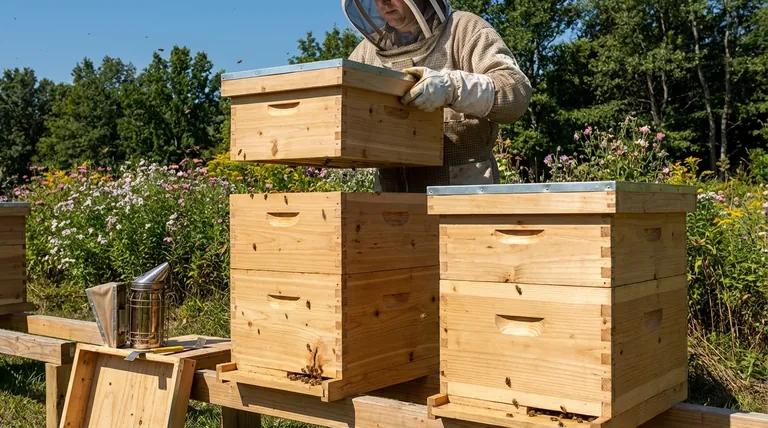The fundamental difference in ease of access between 8-frame and 10-frame hives is a direct trade-off between weight and height. An 8-frame hive features boxes that are significantly lighter and easier to lift individually. In contrast, a 10-frame hive holds more per box, meaning the overall hive is shorter and requires you to work through fewer boxes during an inspection.
The choice is not about which hive is universally "easier" to access, but about which physical challenge you prefer: lifting lighter, more numerous boxes (8-frame) or lifting fewer, but heavier, boxes (10-frame).

The Weight Factor: Why 8-Frame Hives Are Easier to Lift
The most cited advantage of the 8-frame system is the significant reduction in weight. This impacts every interaction you have with the hive.
Lighter Individual Boxes
An 8-frame box is narrower than a 10-frame box, reducing its weight by approximately 10 pounds when full. This difference is substantial, especially when a deep hive body is full of brood, pollen, and honey.
Reduced Physical Strain
For beekeepers, hive inspections and honey harvesting involve repeatedly lifting and moving these boxes. Reducing the weight of each lift minimizes back strain and makes the physical work of beekeeping more manageable and sustainable.
Easier Handling for All Beekeepers
The lighter weight makes beekeeping more accessible to a wider range of people. Many beekeepers switch from 10-frame to 8-frame equipment specifically to reduce the physical demands of the hobby.
The Height Factor: Why 10-Frame Hives Can Be Easier to Inspect
While heavier, the 10-frame hive's greater capacity per box creates a different kind of accessibility advantage related to the hive's total size.
Fewer Boxes Overall
Because each 10-frame box holds more frames, a strong colony will require fewer boxes to be stacked vertically. This results in a shorter, more compact hive.
Less Vertical Work
During a full hive inspection, you must remove every box above the one you want to examine. A shorter hive means there are simply fewer boxes to lift off and set aside, potentially speeding up the process.
Increased Stability
The wider base of a 10-frame hive makes it less prone to tipping over compared to a taller, narrower 8-frame hive. This can be a practical advantage in windy areas or on slightly uneven ground.
Understanding the Trade-offs
Neither system is perfect. The accessibility advantage of one is a direct disadvantage in the other. Your choice depends on which compromise you are more comfortable with.
The 8-Frame Compromise: More Lifts
While each box is lighter, a thriving colony will require more of them. You will find yourself lifting more frequently and managing a taller stack of boxes as the season progresses.
The 10-Frame Compromise: Heavier Lifts
This is the most significant barrier. A full 10-frame deep box can be exceptionally heavy, making it difficult or impossible for some people to manage without assistance.
Equipment and Interchangeability
Ten-frame equipment is the traditional industry standard, making it slightly more common. However, frames themselves are interchangeable between the two systems as long as they are the same depth (e.g., a deep frame from an 8-frame box will fit in a 10-frame deep box).
Making the Right Choice for Your Goal
Your physical capabilities and beekeeping philosophy should guide your decision.
- If your primary focus is minimizing back strain: The 8-frame hive is the clear winner, as its lighter individual boxes make every lift easier.
- If your primary focus is maximizing honey storage in a shorter hive: The 10-frame hive offers more volume per box, potentially requiring a less tall and more stable configuration.
- If your primary focus is emulating the bees' natural environment: The narrower, taller cavity of an 8-frame hive is often considered closer to what bees prefer in the wild and can be better for winter survival.
Ultimately, choosing the right hive is about selecting the tool that best fits your body and your beekeeping goals.
Summary Table:
| Feature | 8-Frame Hive | 10-Frame Hive |
|---|---|---|
| Box Weight | Lighter (easier to lift) | Heavier (more strain) |
| Hive Height | Taller (more boxes) | Shorter (fewer boxes) |
| Primary Advantage | Reduced physical strain per lift | Fewer boxes to move during inspection |
| Best For | Beekeepers prioritizing ease of lifting | Beekeepers prioritizing a compact, stable hive |
Ready to build a hive system that works for you?
At HONESTBEE, we supply durable, high-quality beekeeping supplies and equipment to commercial apiaries and distributors. Whether you're standardizing on 10-frame equipment or looking for the ergonomic benefits of 8-frame systems, we provide the reliable wholesale solutions you need to succeed.
Let's discuss the best equipment for your operation. Contact our team today for expert advice and wholesale pricing!
Visual Guide

Related Products
- Langstroth Bee Hives Bee Keeping Box for Beginners Beekeeping
- HONESTBEE Professional Long Handled Hive Tool with Precision Cutting Blade
- HONESTBEE Advanced Ergonomic Stainless Steel Hive Tool for Beekeeping
- Professional Insulated Plastic Bee Hives
- Long Langstroth Style Horizontal Top Bar Hive for Wholesale
People Also Ask
- How does the orientation of the hive sides benefit comb construction? Ensure Straight, Movable Combs for Easier Hive Management
- What are the different types of beehive boxes available? Choose the Right Hive for Your Apiary
- Why might a beginner be advised to start with a Langstroth hive? Unlock a Supportive Beekeeping Ecosystem
- Should a beginner try a different type of hive? Start with a Langstroth for a solid foundation.
- What are the key features of the Langstroth beehive? A Guide to the Standard for Modern Beekeeping



















